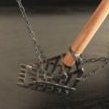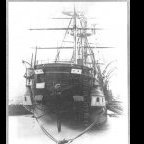-
Posts
13,154 -
Joined
-
Last visited
Reputation Activity
-
 druxey got a reaction from Greg Davis in L'Invention 1799 by Greg Davis - Scale 1:48
druxey got a reaction from Greg Davis in L'Invention 1799 by Greg Davis - Scale 1:48
Very good point, Christian! And, depending on the specie of wood, there may be seasonal expansion and contraction....
-
 druxey reacted to Kenchington in Staghound 1850 by rwiederrich - 1/96 - Extreme Clipper
druxey reacted to Kenchington in Staghound 1850 by rwiederrich - 1/96 - Extreme Clipper
Last year, I got to drive 12-inch bronze carriage bolts lengthwise through 4-inch square teak sheet bits. The bits were glued from separate halves (4 by 4 teak being unobtainable here), so I started the bolt holes on the router table, making half-round grooves before gluing, then cleaned them up with an auger bit before trying to get the bolts through. It was still terrifying! What if the bolts stuck when half way through? There would be no way to get them out again. Fortunately, with the right lubricant and the capability to screw the bolts through, all went OK.
But compare that to the drift bolts (no screw threads) that MacKay's men drove! Worse, consider Great Western, the first of the big purpose-built Atlantic steamers. She had four rows of iron bolts driven fore-and-aft through her floors and futtocks, the bolts in each row overlapping one another. Each bolt was 1.5 inches in diameter and 24 feet long.
How on Earth did they bore the holes precisely enough to be sure that the bolts would not bind long before they were driven home? Come to that, how do you pound the end of a 24 ft bolt with a sledge hammer and drive it into its hole, without the exposed part of the bolt bending? And yet the job was done.
Trevor
-
 druxey reacted to Mark Pearse in Ranger type yacht by Mark Pearse - 1:12 - SMALL
druxey reacted to Mark Pearse in Ranger type yacht by Mark Pearse - 1:12 - SMALL
Since the last post, the cockpit sole was given the weathering treatment. The seat backrests are made but won't go on yet as they will restrict access for other pieces.
A feature of these yachts is the varnished removable hatches either side of the companionway storm boards, & other varnished details. They are a really nice part of the cockpit area & of course will draw the eye to them on the model. So, with some hesitation I started fitting these pieces, after varnishing them (shellac, to a satin finish). The deck also got painted, matt blue with gloss white edges. On the photo below, cover strips & edge details are still to be added.
This photo to show the finish, & the nice glow of the timber (Queensland Maple on the model, Teak on the yacht).
And the fore hatch also:
-
 druxey reacted to AnobiumPunctatum in L'Invention 1799 by Greg Davis - Scale 1:48
druxey reacted to AnobiumPunctatum in L'Invention 1799 by Greg Davis - Scale 1:48
It's not only the problem which David mentioned. It's also a simple problem working with wood (and also other materials). If you cut and grind your wooden parts 100% exactly to the line, your model keel will be 0.4 to 0.5 mm longer than planned (depends if you have 5 or 6 parts). The glue needs also some space. My experience say that you have to think on 0.1mm for every joint. If you add some thin paper for the caulking you need at minimum 0.15 to 0.2mm for the joint.
Especially at the keel this gives your model some extra length.
With manually cutted parts you can't avoid this.
-
 druxey reacted to Greg Davis in L'Invention 1799 by Greg Davis - Scale 1:48
druxey reacted to Greg Davis in L'Invention 1799 by Greg Davis - Scale 1:48
I milled the scarf joining the apron and rising wood segment, then glued the pieces together and set them under glass for more than a day. My plan is to shape the fore side of the subassembly so it matches with the previously made section. Then I will shape the inner side followed by milling the more delicate scarf on the end of the rising wood piece.
-
 druxey reacted to Greg Davis in L'Invention 1799 by Greg Davis - Scale 1:48
druxey reacted to Greg Davis in L'Invention 1799 by Greg Davis - Scale 1:48
Just a quick update:
It's taken a few days but the fore-foot (b) and stem (c) are connected, shaped and ready to accept the apron (g) as well as the first section of the rising wood (e1). I expect that it will take quite a few more hours of careful shaping to get g and e1 nicely fayed to b and c. The fore-foot (h1) already is shaped to fit correctly to b (and to the next part of the false keel h2).
-
 druxey got a reaction from Thukydides in HMS Echo by Hamilton - Admiralty Models - 1:48 - cross-section
druxey got a reaction from Thukydides in HMS Echo by Hamilton - Admiralty Models - 1:48 - cross-section
Coming along nicely! Often, time away from the model lets one's subconscious come up with the answer to a problem.
-
 druxey got a reaction from hamilton in HMS Echo by Hamilton - Admiralty Models - 1:48 - cross-section
druxey got a reaction from hamilton in HMS Echo by Hamilton - Admiralty Models - 1:48 - cross-section
Coming along nicely! Often, time away from the model lets one's subconscious come up with the answer to a problem.
-

-
 druxey reacted to ccoyle in HMS Wolf 1754 by catopower - FINISHED - Shipyard - 1/72 Admiralty Style - CARD
druxey reacted to ccoyle in HMS Wolf 1754 by catopower - FINISHED - Shipyard - 1/72 Admiralty Style - CARD
Looks great as-is, but I'm sure you'd make it look great with rigging, too.
-
 druxey reacted to catopower in HMS Wolf 1754 by catopower - FINISHED - Shipyard - 1/72 Admiralty Style - CARD
druxey reacted to catopower in HMS Wolf 1754 by catopower - FINISHED - Shipyard - 1/72 Admiralty Style - CARD
Also, I like the way this model looks so much that I'm afraid of ruining it when I get into the rigging.
I quickly made a flagstaff and mounted the kit's flag. Also, started looking at building up the stern lantern.
In the meantime, the Wolf makes a fine display...
I've since given the flag a shot of matte clear lacquer to take some of the sheen off of it. If it bothers me enough, I'll just print my own flag, as that seemed to work pretty well on the yacht Mary model
Note that I haven't placed the deck pumps. They're done and ready to be mounted, but to prevent damage to them, I chose to leave them off. I may just tack them into place like I did the officer figure, so they can be removed should I eventually decide to rig.
Regarding rigging, though this is more lightly rigged than a three-masted square rigger, like a frigate, those larger ships have larger masts and yards, and I think they may actually be easier to rig, at least for fat fingers.
Thoughts?
I'm tempted to take one of my 1/72 scale Shipyard frigate hulls this far, and see about rigging that. And, even if it doesn't go beyond this stage, it makes a pretty nice display model. And, without the masts, yards, and all, it requires a MUCH smaller case and takes up that much less room in the house to display... 🤔
-
 druxey reacted to hamilton in HMS Echo by Hamilton - Admiralty Models - 1:48 - cross-section
druxey reacted to hamilton in HMS Echo by Hamilton - Admiralty Models - 1:48 - cross-section
A bit more work on the upper deck framing. I've made all three of the deck beams and started to refine them (they're not quite finished but I'm not aiming for perfection, so....). My main task now is to make a framing jig so I can assemble at least the major components (beams, beam arms & carlings) off the model as I did with the lower deck. As of now I've gotten as far as making a template of the deck with the beams marked on. My model deviates slightly from the layout given in the practicum (modeller error is the blame here) so I'll use the drawings as reference for finishing the template.
I had thought of making a simple jig - fitting a couple of 1" (scale) thick battens along the port and starboard side to simulate the deck clamps (into which beams are let down 1") and then a 5-1/2" batten down the centre line (the deck rounds up by 5-1/2"). We'll see how this goes and whether I need to expand on this basic concept.....
I am a little concerned about the beam arms - these seem to be a little finicky to get right considering the round up needs to be sanded into them as well....I'm going to be away for a couple of weeks as of Friday and this week's a busy one getting ready to go, so it's hit or miss whether there'll be any time in the shop...but...in the meantime enjoy the photos and happy modelling.
hamilton
-
 druxey got a reaction from FriedClams in Pomeranian Rahschlup 1846 by wefalck – 1/160 scale – single-masted Baltic trading vessel
druxey got a reaction from FriedClams in Pomeranian Rahschlup 1846 by wefalck – 1/160 scale – single-masted Baltic trading vessel
Thank you for the photo of your Frankenmill, Eberhard! You made me smile.
-
 druxey reacted to wefalck in Pomeranian Rahschlup 1846 by wefalck – 1/160 scale – single-masted Baltic trading vessel
druxey reacted to wefalck in Pomeranian Rahschlup 1846 by wefalck – 1/160 scale – single-masted Baltic trading vessel
Well, it's a vintage milling machine that never was: https://www.maritima-et-mechanika.org/tools/micromill/micromill.html. The key mechanical parts came from antique watchmaking lathes.
https://www.maritima-et-mechanika.org/tools/micromill/MF-V1.mp4
The miniature vice is shop-made: https://www.maritima-et-mechanika.org/tools/attachments/attachments.html#Micro_vice
-
 druxey got a reaction from Archi in Yacht Mary by catopower - FINISHED - Mamoli Dusek - 1:54 - An Inherited Model
druxey got a reaction from Archi in Yacht Mary by catopower - FINISHED - Mamoli Dusek - 1:54 - An Inherited Model
Nicely completed, Clare. The Royal Standard is flown only when the king was aboard. He must be below, somewhere aft.... Usually jack was flown from the jackstaff on the bowsprit. No criticism - just thought you'd like to know.
(The painting is of the second or new Mary - not to be confused with the original Dutch Mary. In this instance, the yacht is carrying William of Orange. His standard flies from the masthead.)
-
 druxey got a reaction from CiscoH in HMS Crocodile 1781 by Pirate adam - 1/48 scale - POF
druxey got a reaction from CiscoH in HMS Crocodile 1781 by Pirate adam - 1/48 scale - POF
Very convincing framing pattern, Adam. (I missed your April post until now.) And you were so right to correct alignment early, or it would have been certain to come back and bite you!
-
 druxey got a reaction from Keith Black in HMS Crocodile 1781 by Pirate adam - 1/48 scale - POF
druxey got a reaction from Keith Black in HMS Crocodile 1781 by Pirate adam - 1/48 scale - POF
Very convincing framing pattern, Adam. (I missed your April post until now.) And you were so right to correct alignment early, or it would have been certain to come back and bite you!
-
 druxey reacted to Pirate adam in HMS Crocodile 1781 by Pirate adam - 1/48 scale - POF
druxey reacted to Pirate adam in HMS Crocodile 1781 by Pirate adam - 1/48 scale - POF
I forgot to show my high tech gluing setup. I glue them on a small plate of glass and weigh them down with a flashlight.
-
 druxey reacted to Pirate adam in HMS Crocodile 1781 by Pirate adam - 1/48 scale - POF
druxey reacted to Pirate adam in HMS Crocodile 1781 by Pirate adam - 1/48 scale - POF
Picture with a bit more resolution.
-
 druxey reacted to Pirate adam in HMS Crocodile 1781 by Pirate adam - 1/48 scale - POF
druxey reacted to Pirate adam in HMS Crocodile 1781 by Pirate adam - 1/48 scale - POF
Here I have begun to glue up the aft cant frames. I will cut the spaces later for the chocks using the mill.
-
 druxey reacted to Pirate adam in HMS Crocodile 1781 by Pirate adam - 1/48 scale - POF
druxey reacted to Pirate adam in HMS Crocodile 1781 by Pirate adam - 1/48 scale - POF
With the transom shenanigans out of the way I am finally ready to start making frames. Here I have marked out the blanks for the aft cant frames. The black lines are the actual lines for the frames. I added the green lines to make sure I have plenty of wood for fairing the cant frames as well as to make sure the frames are sufficiently tall. Experience tells me that I just can't help myself when it comes to leaving enough wood otherwise.
Familiar sight for anyone who has built POF.
Adam
-
 druxey reacted to Pirate adam in HMS Crocodile 1781 by Pirate adam - 1/48 scale - POF
druxey reacted to Pirate adam in HMS Crocodile 1781 by Pirate adam - 1/48 scale - POF
I made a slightly larger building board to provide a bit more room to install the frames at the ends of the model. Long story short, when I setup the new build board I found some issues with the alignment of the transoms and aft fashion piece. I have known for a while that something wasn't right with the alignment, and happy to figure it out before doing a ton more work. I envisioned this would be a problem that would follow me through the whole build, so got out the isopropyl and re-built the transoms and aft fashion pieces. I also used the opportunity to add a 4th filling frame which looks much better to my eyes.
Adam
-
 druxey reacted to Pirate adam in HMS Crocodile 1781 by Pirate adam - 1/48 scale - POF
druxey reacted to Pirate adam in HMS Crocodile 1781 by Pirate adam - 1/48 scale - POF
No posts for a while, but I have been very busy over the winter revising some drafting before I cut out the remaining cant frames. I'm finally feeling good about the framing layout, so back to cutting wood. I will have some actual progress soon. The drawing below is where I netted out on the framing layout. I had originally intended to use the framing plan from the AOT Pandora book, but moved away from that based on the other references available. There wasn't a complete framing drawing available from the NMM for Crocodile or any of the other Porcupine class ships, but there are partial framing plans available from for sister ships Siren and Hyena. There is also a full framing plan available for the Sphinx of 1775, which is a smaller, but similar ship. I used those along with the scantlings for the 24 gun ship from Steel combined with the assumptions below to arrive at my final layout. There is some guessing involved, but I don't suspect anyone will ever look at the finished model and tell me convincingly that it is wrong. I am satisfied with the result.
Assumptions used in frame layout:
1) All floors equally spaced and following both the dimensions and room and space from Steel
2) Frames aligned in line with all the frames shown on the partial framing diagram for Siren 1779
3) Minimal use of cast and shifted frames to assure frames were aligned with each gunport
4) Maximum use of top timbers to align with the timber heads shown on the plan.
5) Cant frame angles adjusted to line up with both gunport and top timbers whenever possible.
The assumptions above actually resulted in a layout very similar to the one for Sphinx which I actually only came across when I was 90% done with drafting.
-
 druxey reacted to rwiederrich in Staghound 1850 by rwiederrich - 1/96 - Extreme Clipper
druxey reacted to rwiederrich in Staghound 1850 by rwiederrich - 1/96 - Extreme Clipper
Masked and painted.
Rob
-
 druxey got a reaction from FriedClams in Pomeranian Rahschlup 1846 by wefalck – 1/160 scale – single-masted Baltic trading vessel
druxey got a reaction from FriedClams in Pomeranian Rahschlup 1846 by wefalck – 1/160 scale – single-masted Baltic trading vessel
That is a fascinating looking vintage milling machine!







